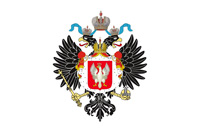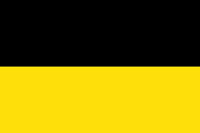World War I (1914-1918)

Second Battle of the Masurian Lakes
The Second Battle of the Masurian Lakes, also known as the Winter Battle of the Masurian Lakes, was the northern part of the Central Powers' offensive on the Eastern Front in the winter of 1915. The offensive was intended to advance beyond the Vistula River and perhaps knock Russia out of the war.
Background
The Central Powers planned four offensives on their Eastern Front in early 1915. The Germans The German Empire, also referred to as Imperial Germany, the Second Reich, as well as simply Germany, was the period of the German Reich from the unification of Germany in 1871 until the November Revolution in 1918, when the German Reich changed its form of government from a monarchy to a republic. During its 47 years of existence, the German Empire became the industrial, technological, and scientific giant of Europe., led by Paul von Hindenburg, would attack eastward from their front line in western Poland
The German Empire, also referred to as Imperial Germany, the Second Reich, as well as simply Germany, was the period of the German Reich from the unification of Germany in 1871 until the November Revolution in 1918, when the German Reich changed its form of government from a monarchy to a republic. During its 47 years of existence, the German Empire became the industrial, technological, and scientific giant of Europe., led by Paul von Hindenburg, would attack eastward from their front line in western Poland Congress Poland, Congress Kingdom of Poland, or Russian Poland, formally known as the Kingdom of Poland, was a polity created in 1815 by the Congress of Vienna as a semi-autonomous Polish state, a successor to Napoleon's Duchy of Warsaw. It was established when the French ceded a part of Polish territory to the Russian Empire following France's defeat in the Napoleonic Wars. In 1915, during World War I, it was replaced by the German-controlled nominal Regency Kingdom until Poland regained independence in 1918., which had been occupied after the Battle of Łódź in 1914, toward the Vistula River and also in East Prussia in the vicinity of the Masurian Lakes (site of the 1914 Battle of the Masurian Lakes). The Austro-Hungarians
Congress Poland, Congress Kingdom of Poland, or Russian Poland, formally known as the Kingdom of Poland, was a polity created in 1815 by the Congress of Vienna as a semi-autonomous Polish state, a successor to Napoleon's Duchy of Warsaw. It was established when the French ceded a part of Polish territory to the Russian Empire following France's defeat in the Napoleonic Wars. In 1915, during World War I, it was replaced by the German-controlled nominal Regency Kingdom until Poland regained independence in 1918., which had been occupied after the Battle of Łódź in 1914, toward the Vistula River and also in East Prussia in the vicinity of the Masurian Lakes (site of the 1914 Battle of the Masurian Lakes). The Austro-Hungarians Austria-Hungary, often referred to as the Austro-Hungarian Empire, the Dual Monarchy, or Austria, was a constitutional monarchy and great power in Central Europe between 1867 and 1918. Austria-Hungary was one of the Central Powers in World War I, which began with an Austro-Hungarian war declaration on the Kingdom of Serbia on 28 July 1914. would emerge from the Carpathian Mountain passes to attack the Russians by driving toward Lemberg. They would be led by General Alexander von Linsingen. Further south General Borojevic von Bojna would attempt to relieve the besieged fortress at Przemysl.
Austria-Hungary, often referred to as the Austro-Hungarian Empire, the Dual Monarchy, or Austria, was a constitutional monarchy and great power in Central Europe between 1867 and 1918. Austria-Hungary was one of the Central Powers in World War I, which began with an Austro-Hungarian war declaration on the Kingdom of Serbia on 28 July 1914. would emerge from the Carpathian Mountain passes to attack the Russians by driving toward Lemberg. They would be led by General Alexander von Linsingen. Further south General Borojevic von Bojna would attempt to relieve the besieged fortress at Przemysl.
The Attack
German Chief of Staff Erich von Falkenhayn strongly believed that the war would be won on the Western Front. Nonetheless, he sent four additional army corps to Paul von Hindenburg, commander of their Eastern Front. By February 1915, thirty-six percent of the German field army was in the east.
German Ninth Army attacked from Silesia into Poland at the end of January; they released tear gas, which stopped their assault by blowing back on the attackers. The Russians Russian Empire was an empire and the final period of the Russian monarchy from 1721 to 1917, ruling across large parts of Eurasia. The rise of the Russian Empire coincided with the decline of neighbouring rival powers: the Swedish Empire, the Polish–Lithuanian Commonwealth, Qajar Iran, the Ottoman Empire, and Qing China. Russia remains the third-largest empire in history, surpassed only by the British Empire and the Mongol Empire. counterattacked with eleven divisions under a single corps commander, losing 40,000 men in three days. In East Prussia, further Russian incursions were blocked by trench lines extending between the Masurian Lakes; they were held by the German Eighth Army, commanded by General Otto von Below. The Eighth Army was reinforced by some of the newly arrived corps, while the rest of them became the German Tenth Army, commanded by Colonel-General Hermann von Eichhorn, which was formed on the German left. The Tenth Army was to be one wing of a pincers intended to surround their opponents: General Sievers' Russian Tenth Army. A new Russian Twelfth Army under General Pavel Plehve was assembling in Poland roughly 100 km (62 mi) to the southwest.
Russian Empire was an empire and the final period of the Russian monarchy from 1721 to 1917, ruling across large parts of Eurasia. The rise of the Russian Empire coincided with the decline of neighbouring rival powers: the Swedish Empire, the Polish–Lithuanian Commonwealth, Qajar Iran, the Ottoman Empire, and Qing China. Russia remains the third-largest empire in history, surpassed only by the British Empire and the Mongol Empire. counterattacked with eleven divisions under a single corps commander, losing 40,000 men in three days. In East Prussia, further Russian incursions were blocked by trench lines extending between the Masurian Lakes; they were held by the German Eighth Army, commanded by General Otto von Below. The Eighth Army was reinforced by some of the newly arrived corps, while the rest of them became the German Tenth Army, commanded by Colonel-General Hermann von Eichhorn, which was formed on the German left. The Tenth Army was to be one wing of a pincers intended to surround their opponents: General Sievers' Russian Tenth Army. A new Russian Twelfth Army under General Pavel Plehve was assembling in Poland roughly 100 km (62 mi) to the southwest.
Sievers warned the Northwest Front commander, General Nikolai Ruzsky, that they were likely to be attacked, but was ignored. On February 7, despite a heavy snowstorm, the left wing of Below's Eighth Army launched a surprise attack against Sievers, whose trenches were shallow, disconnected ditches, with little or no barbed wire because the first shipments had not arrived until December 1914. The following day, the German Tenth Army also drove forward. Snow, with drifts as high as a man, slowed German progress down the roads for the first two days; off the roads, the ground was too boggy for fighting. Despite these formidable obstacles, the German pincers advanced 120 km (75 mi) in a week, inflicting severe casualties on the Russians. As the Russians withdrew, the center of the German Eight Army began to thrust forward. The Russian withdrawal was disorderly; many prisoners were taken. Russian counterattacks on the lengthening flank of the German Tenth Army were beaten back. German men and horses fed on captured provisions, so only ammunition had to be hauled up to them. The snow was then washed away by torrential rain. The climax of the battle was on February 18, when the Russian 20th Army Corps, under General Bulgakov, was surrounded by the German Tenth Army in the vast Augustow Forest. On February 21, the survivors from the corps surrendered.
The heroic stand of the Russian 20th Corps provided the time required for the rest of the Russian Tenth Army to form a new defensive position. On February 22, the day after the surrender of the 20th Corps, Plehve's Russian Twelfth Army counterattacked, which checked further German advances and brought the battle to an end. One source gives Russian losses as 92,000 prisoners and 300 guns, while another gives 56,000 men and 185 guns. The Germans lost 7,500 men and 14 guns.
The Germans besieged the Russian fortress at Osowiec, but were unable to take it.
Outcome
The Second Battle of the Masurian Lakes gave the Germans a toehold in Russia; however, the Russians blocked further advances. In the following weeks, the Germans drove the Russians out of their remaining small enclaves in East Prussia.
Further south, Alexander von Linsingen's offensive had failed with severe losses, and the fortress at Przemysl had been forced to surrender to the Russians. Clearly, the first Austro-Hungarian offensives of 1915 were abject failures. Henceforth, the Austro-Hungarians and Germans would work together more closely.
HISTORY

RESOURCES
This article uses material from the Wikipedia articles "World War", "World War I", and "Second Battle of the Masurian Lakes", which is released under the Creative Commons Attribution-Share-Alike License 3.0.
© Stories Preschool. All Rights Reserved.










